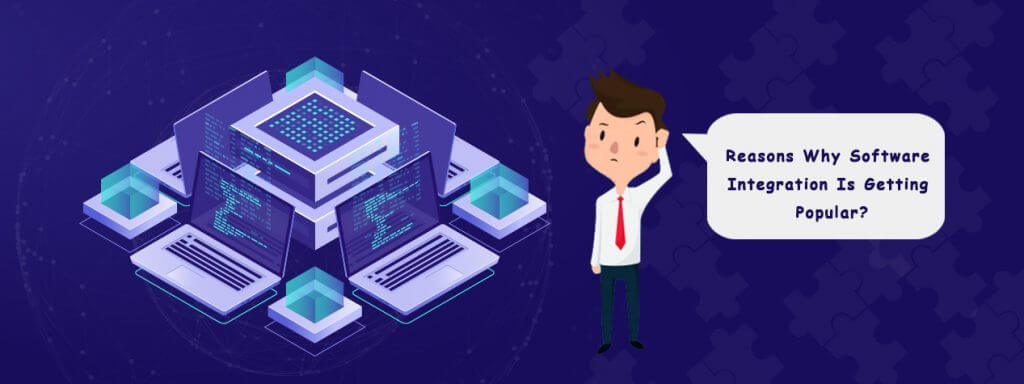Integration is all about connecting the dots!
There is data, data everywhere!
Even when you buy a pack of white cheddar popcorn from any Kroger store, it becomes data for the store for keeps and use.
Imagine the plight of Kroger or the likes, collecting loads of unstructured data from various systems with every passing hour without any consideration for data integration. Imagine the value, the opportunities lost in scattered data, let aside the time and money spent in gathering and storing all the data?
To skip over all that turmoil, the data is integrated to make it easier for stakeholders to make better and informed business decisions.
Software Integration is about the development of an architecture that coalesces distinctive software systems to function in conglomeration. Organizations opt for software integration services that architect the work closely with the teams into software development, to consolidate the data, processes, applications and achieve an efficient and coherent system for them.

Software Integration has become Momentous than Ever, Why?
The technological developments have been changing the business environment or system, time to time, thereby giving rise to business application challenges.
To Handle the Complexities of Modern Day Business System
Owing to the modern day business system which is no longer composed of single large block, but is based upon a number of permutation and combinations, the need of software integration is growing, to avoid disparity and enhance the value of data assets.
For Integration of Relevant Data
Today, there is no limit to data growth with nearly unlimited potential for storage and processing. From small to large industries, nearly all depend upon data for decision-making whether processed manually or through automation and integrated systems. Simply accessing all the data doesn’t get results. The data has to be relevant so that the right decision is taken. Deriving correct data from multiple sources can be unwieldy, may hamper decision-making and thus may upset the business as a whole. Methodological data integration is what allows such data to be accessed in a meaningful manner.
Many are attempting to lead by data, but unfortunately, some are not able to do so! The struggle continues and in most cases it’s relevant that it’s due to poor planning. To be able to achieve so, an organization needs to develop an overall strategy, a blueprint – an architecture that allows visibility into all systems and processes and further on, a well-defined plan to integration.
To Manage Hybrid Integration Challenges
As organizations add cloud-based applications to their existing infrastructure, they need to address the hybrid environment and associated challenges. The software integration solution offers cost-effective and agile cloud and on-premise app integration.
To Manage Application Program Interface (API)
In the ongoing era of digital transformation, as the number of channels increases, one of the major challenges will be about management of Application Program Interface (API). Enterprises increasingly need to share their datasets with partners, customers and even third parties. A compatible integration solution allows to build, maintain and manage APIs in the same environment in which other integration works.
To Deal with Prospective IoT Integration Challenges
As the businesses scale up, the requirements associated with Internet of Things (IoT) are going to get complex, for which the cloud-based solution will help immensely. The challenges like implementation of multilevel workflows, management of multiple IoT projects with shared components, implementation of advanced integration features will need to be handled by an integration solution.
Apart from streamlining the data and processes, software integration leads to Single Sign-On (SSO), augmented process efficiency, better visibility, productivity and profitability.

Cloud Integration, the New Normal
Cloud Integration has revolutionized the integration system as it has helped businesses deal with the age-old battle about data silos. Companies could get a comprehensive access into their data with better functionality. Not only this, Cloud Integration is magnetizing the larger area with the advent of Software as a Service (SaaS) solutions today.
Know about 6 Trends to Watch Out in 2020!
Cloud Integration – Definitely, Not a Child’s Play!
It is interesting to note that, today the cloud technology is used by whopping 93% of businesses in America!
It has never been so easy, though!
The complete integration of cloud technology in an existing business system requires tremendous effort, owing to the challenges that come across like, storage constraints, shifts between private, public and hybrid cloud systems complicating the integration process further, and issues related to information technology. A cloud architect with a hands-on experience in cloud integration can help shape the new system with well managed change management processes.
To stay in pace with rapidly changing technological trends, businesses need to keep a watch on latest API trends, and evolve by upgrading their processes, time to time. But with segregated applications, upgrading these processes will be a challenge and may even lead to crippled flexibility, productivity, and growth. An efficient integrated software helps prevent ‘software hairballs’ and process bottlenecks at various levels and enables the businesses to grow without getting into the technological maelstrom.
Tarika Group offers system integration services keeping in mind, few things while integrating systems, for streamlined process, better efficiency, increased productivity, and organizational growth.

